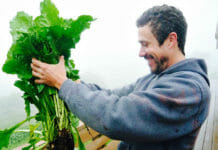
As a member of the Anchor Run Farm CSA (community supported agriculture), we receive weekly updates from our farmers, Dana Hunting and Derek McGeehan. I always enjoy their emails. They are a cross between farm report and nature essay. I like them too because they inform and educate, sharing how my vegetables grow and the in’s and out’s of sustainable, organic agriculture. With their permission, I reprint some of their weekly reports. If you are interested in becoming a member of the Anchor Run CSA, see their website for more information.
by guest blogger Dana Hunting,
September 4, 2011: What a season of extremes! Extreme dry, then extreme wet, occasionally extremely perfect. Before I get ahead of myself, I should mention that we weathered Hurricane Irene fairly well and were lucky enough to not lose power. The crops did get blown around a bit, but most should be fine except for half of our sunflower cover crop which is laying down, though flowering.
Not surprisingly the worst damage was caused by excess water in an already saturated soil. It’s a product of the relentless wetness of August that I’m able to say we only received 5.2 inches of rain through the whole storm, and we were fortunate to receive just that. Still, 5.2 inches was 5.2 inches too much and our fields withstood a bit of erosion from the sustained deluge. Sadly, Irene was the proverbial “straw that broke the camel’s back” for our second planting of watermelon. Looking better than the first planting, the second wave of watermelon plants took all of the rain August had to deliver and their vines simply died, leaving the beautiful green orbs without a chance of reaching maturity. If that weren’t sad enough, the winter squash is virtually a complete crop failure this year. The plants appear to have succumbed to a combination of a squash bug infestation and, possibly, too wet soil. Similar to the watermelon, the vines died before the fruit reached maturity.
Crop failures are always a risk in farming due to the myriad of environmental factors out of our control. Of course the loss is always disappointing. We try to balance these risks by planting a wide variety of crops where some do well in certain conditions and others thrive in different conditions. For example, the celeriac (celery root) are looking awesome this year, so we can look forward to a bountiful crop of that culinary treasure. So on with the good news…
Finally with the grace of this sun and dry weather we were able to get into the fields last week and get some serious work done. The fields were looking a little ratty there for a couple weeks, but since things have dried out Derek has been spending every waking moment on the tractor cleaning things up and doing ground prep for our Fall crops. We accomplished some much-needed transplanting last week and seeded many of our Fall greens over the weekend. We plan to put row cover over the seedlings to prevent insect damage and speed the growth of the greens, Asian turnips and radishes. With the summer speeding by, those tasty treats should be here before you can say “yum”. In the meantime make some potato leek soup!










![What we’re reading [Oct 16 2017]](https://www.buckscountytaste.com/wp-content/uploads/2017/10/coffee_macbook_reading_pexels-photo-414630-218x150.jpeg)
